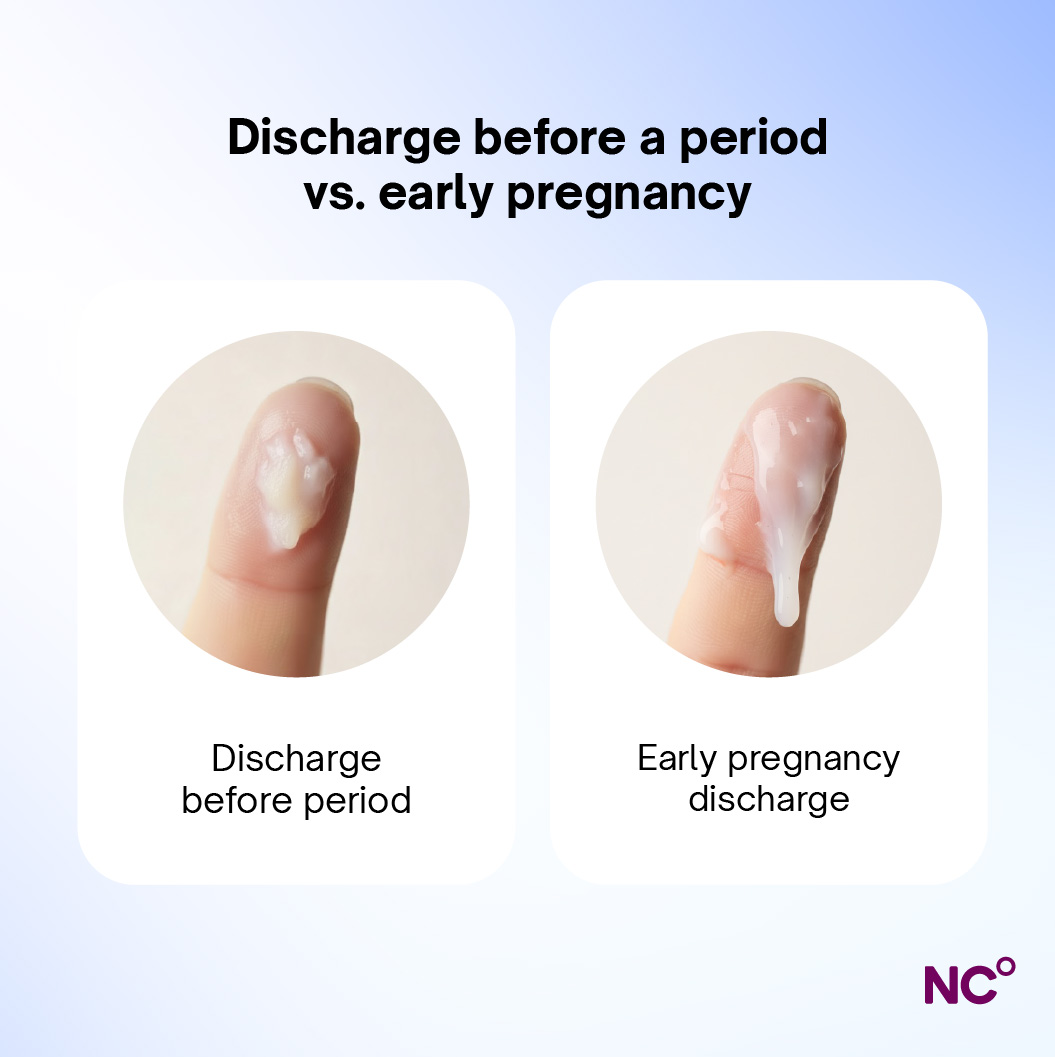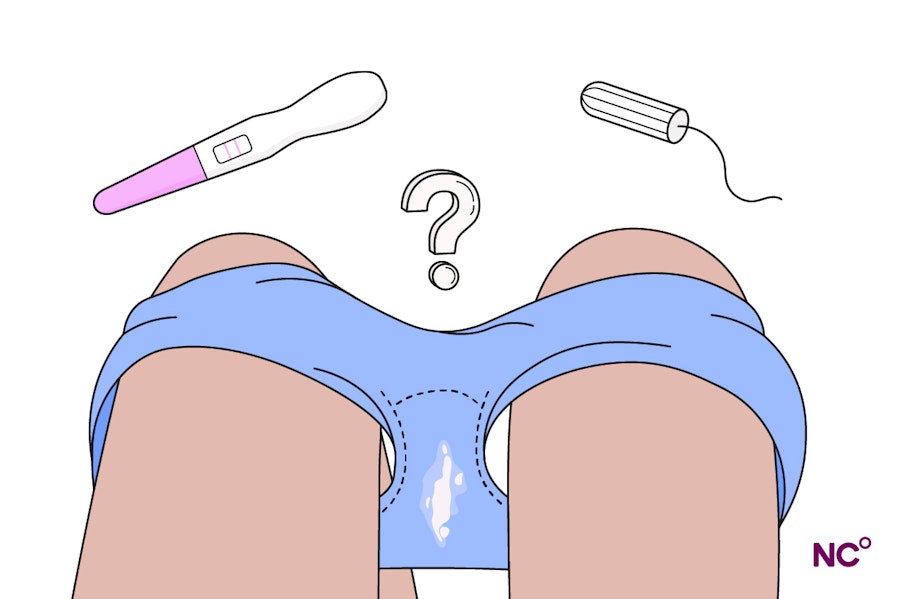Discharge before period vs. early pregnancy: How to tell the difference
Follows NC° Editorial Policy
At Natural Cycles, our mission is to empower you with the knowledge you need to take charge of your health. At Cycle Matters, we create fact-checked, expert-written content that tackles these topics in a compassionate and accessible way. Read more...
Key takeaways:
- Knowing what’s normal for you in terms of discharge is a helpful way to spot any changes
- Throughout pregnancy, particularly early in the first trimester and before giving birth, it’s normal to experience increased vaginal discharge
- Healthy discharge is generally asymptomatic, while discharge that is accompanied by itching, pain, or irritation can be the sign of another health issue
On this page
- What is vaginal discharge?
- How discharge can indicate pregnancy or an upcoming period
- Differences between early pregnancy discharge and discharge before your period
- Is discolored discharge normal during pregnancy?
- Discharge PMS or pregnancy: how to know the difference
- When to consult a doctor
- Know your body with Natural Cycles
Vaginal discharge is something that you might not have noticed or paid attention to until you start monitoring your menstrual cycle or trying to conceive. Changes in your discharge can help signal important phases of fertility, like ovulation or implantation. For those trying to conceive (TTC), you can find yourself constantly on the lookout for early signs of pregnancy. In this article, we will go over some differences that can appear between premenstrual and pregnancy vaginal discharge. Because discharge is not the most reliable or clearest early pregnancy sign, it's important to also be familiar with other pregnancy symptoms that can begin in the days post ovulation (DPO).
What is vaginal discharge?
Vaginal discharge refers to any fluid or mucus that comes out of the vagina. Healthy discharge is commonly thick or sticky, wet, clear or white, mostly odorless, and asymptomatic. If you have discharge that is green or grey, has an unusual or unpleasant smell, and is accompanied by symptoms like itching, discomfort, or pain, this is referred to as symptomatic discharge. Symptomatic discharge often indicates an infection or other health issue [2].
Discharge plays an important role in keeping your vagina clean, moisturized, and protected. Remember, though, that the color, texture, and smell of “normal” discharge can vary from person to person and throughout the phases of your menstrual cycle. Discharge is part of your vagina’s self-cleaning mechanism. You can help keep things healthy down there by avoiding perfumed or scented soaps or hygiene wipes, as these can contribute to vaginal irritation, soreness, and dryness [1].
What is white discharge before a period or during early pregnancy?
White discharge, or leukorrhea, is a common and healthy type of vaginal discharge. Made up of old cells, mucus, and bacteria, leukorrhea usually has little to no odor [3]. Your body produces this type of discharge during your normal menstrual cycle and throughout pregnancy, and white discharge on its own is typically nothing to worry about.
Why does discharge change throughout your cycle?
The color, texture, and even odor of your discharge can change throughout your cycle on account of the rising and falling levels of different hormones [4]. For example, around ovulation, your discharge tends to be thin and clear, with the texture of a raw egg white [5]. This type of discharge is called cervical mucus, or cervical fluid, and is linked to increased levels of the sex hormone estrogen.
The amount of cervical mucus you produce changes throughout your cycle. You’ll produce the least right after your period, which can make you feel kind of dry, but it increases as you get closer to ovulation. At ovulation, your body produces the most cervical mucus, after which the amount will decrease again. The texture can also change throughout your cycle – just after your period it might feel sticky, while leading up to ovulation, it will get wetter and can even feel or look creamy. At ovulation, it is thin, slippery, and stretchy, after which it can thicken again as the quantity decreases [2, 6]. Cervical mucus can be used to help track ovulation, but not a great indicator of pregnancy.
The second half of your cycle, or luteal phase, begins just after ovulation. During the luteal phase, discharge tends to be white or slightly yellow and thicker due to elevated levels of progesterone [4].
If you have any questions or concerns about changes to your cycle, it’s best to consult with a healthcare professional.
How discharge can indicate pregnancy or an upcoming period
If you’re trying to conceive, those DPOs waiting to take a pregnancy test can feel like they're never-ending. Could changes in the quantity and consistency of your discharge be an early pregnancy sign? Let’s look closer at premenstrual and pregnancy discharge, and see what we can watch out for.
Discharge before your period: what it looks like
Before your period, it’s common to experience little to no discharge [6]. If you have discharge, it might be cloudy, sticky or dry in texture. This can vary from person to person.

Early pregnancy discharge: what it looks like
Unfortunately, for those watching for signs of conception, early pregnancy discharge can often resemble premenstrual discharge. Some women might experience thinner than normal discharge, while others might not notice any differences at all [7].
Following implantation, it’s also possible to experience discharge that is brown or red, or light spotting. Implantation is when the fertilized egg implants into the uterine wall. While implantation is an important step in all pregnancies, implantation bleeding is not experienced or observable for everyone.
The biggest thing to note about early pregnancy discharge is that the amount increases beginning as soon as a week from conception [1, 8]. For this reason, experiencing more discharge coming up to your expected period than what is normal for you can be considered an early sign of pregnancy. Unfortunately, though, discharge is not the clearest early pregnancy sign. For that reason, it’s recommended to familiarize yourself with other early symptoms of pregnancy.
Differences between early pregnancy discharge and discharge before your period
|
Before your period |
Early pregnancy |
|
|
Consistency |
Thick, creamy |
Thin, watery |
|
Color |
White, milky, or clear |
White, milky, or clear |
|
Odor |
Mild or odorless |
Mild or odorless |
|
Amount |
Average |
More than average |
|
Other symptoms |
Swollen or tender breasts, constipation or diarrhea, bloating, cramping, headaches, tender breasts, fatigue, irritability, appetite changes, trouble concentrating, tension, anxiety, depression, mood swings [8] |
Missed period or light spotting, breast changes including tingling and/or darkening nipples, nausea (with or without vomiting), increased need to urinate, tiredness, food cravings or aversions, elevated basal body temperature (BBT) [9] |
Is discolored discharge normal during pregnancy?
Healthy discharge during pregnancy is generally white, clear, or slightly yellow. It is also possible to experience slightly pink or red discharge, particularly after having sex, after implantation, or at the end of your pregnancy. However, if you experience bleeding or discharge that is an unusual color, has a strong odor, or is accompanied by any symptoms like itching or pain, contact your doctor [2, 5].
Discharge PMS or pregnancy: how to know the difference
Ultimately, changes between premenstrual and early pregnancy discharge can be very hard to detect, so discharge is not a reliable sign of pregnancy. That said, being familiar with what is “normal” discharge for you throughout your cycle and leading up to your period can help you spot any changes in consistency and amount. Tracking other PMS symptoms can also be a great way to help you notice any differences in the physical or emotional symptoms you are experiencing. A pregnancy test taken after you miss your expected period is the surest way to know if you are pregnant.
When to consult a doctor
If you experience symptoms like pelvic pain, irritation, itching, bleeding, blisters, or sores, contact your doctor [2]. Similarly, if your discharge is a color that is abnormal for you, or if you experience unexplained bleeding or bleeding outside your period, it’s important to contact your physician.
Know your body with Natural Cycles
Did you know that you can use the Natural Cycles app to easily track discharge during your cycle on your phone? Natural Cycles is the only FDA-cleared birth control app, offering a hormone-free way to plan or prevent pregnancy. With tools to track cycle symptoms and guidance on when it’s time to take that first pregnancy test, Natural Cycles can support you every step of the way. Couples who use Natural Cycles to plan pregnancy conceive in three cycles on average. Why not try Natural Cycles today?
Did you enjoy reading this article?
